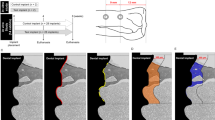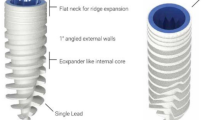Summary
The titanium bone growth chamber consists of two titanium disks held together by two screws. At the level of the intersection between the disks, a 1 mm wide canal penetrates the implant. After implantation, in e.g. the rabbit, tibial metaphysis bone and vessels will grow through this canal, the contents of which are collected four weeks after surgery. Microradiography and a computer-based analysis give a numerical representation of the amount of newly formed bone in the canal. When the bone ingrowth into two identical titanium implants, one inserted in the left and the other in the right tibia, was compared, only small and insignificant differences were found in the same animal. However, when one animal was compared to another, greater differences in the bone-forming capacity were found, in spite of the fact that the rabbits were controlled with respect to race, age and sex. The osseous penetration rate into titanium canals was compared to the bone ingrowth in equally sized pipes of polymerized acrylic cement which had been inserted in the titanium chamber. In these cases there was significantly less bone formed in the cement pipes compared to the titanium controls. Poor biocompatibility of the cement compared to titanium is suggested to be one factor responsible for the reduced bone formation in the cement environment. This may be one reason for the fibrous tissue capsule generally seen around cemented implants.
Zusammenfassung
Die sogenannte „Knochenwuchskammer” besteht aus zwei Titaniumscheiben, die durch zwei Schrauben zusammengehalten werden. Auf der Kontaktebene zwischen den Scheiben wird das Implantat von einem 1 mm breiten Kanal durchzogen. Nach der Implantation, z. B. in die Tibiametaphyse des Kaninchens, wachsen Knochen und Blutgefäße in diesen Kanal, die 4 Wochen nach der Implantation entnommen werden. Mikroradiographie und Computeranalyse ergeben eine numerische Erfassung der neugebildeten Knochenmenge in dem Kanal. Nach der Implantation identischer Titanium-implantate in die rechte und linke Tibiametaphyse des gleichen Tieres wurden nur unbedeutende Differenzen der Knochenmenge gefunden. Beim Vergleich verschiedener Tiere miteinander wurden größere Unterschiede festgestellt, obwohl es sich um Tiere handelte, die hinsichtlich Rasse, Alter und Geschlecht vergleichbar waren. Die knöcherne Penetrationsrate in den Titaniumkanälen wurde mit dem Einwachsen von Knochengewebe in gleich große Röhren aus polymerisiertem Acrylzement verglichen, die in die Titaniumkammer eingesetzt worden waren. In diesen Fällen hatte sich signifikant weniger Knochen in den Zementröhren gebildet. Es wird angenommen, daß die geringere Biokompatibilität des Zementes, verglichen mit Titanium, einer der verantwortlichen Faktoren für die reduzierte Knochenneubildung ist. Dies könnte eine Ursache für die fibröse Gelenkkapsel sein, die generell um zementierte Implantate herum gesehen wird.
Similar content being viewed by others
References
Albrektsson T, Brånemark P-I, Hansson H-A, Lindström J (1981) Osseointegrated titanium implants. Requirements for ensuring a long-lasting, direct bone anchorage in man. Acta Orthop Scand 52:155–170
Albrektsson T, Bach A, Edshage S, Jönsson A (1982a) Fibrin Adhesive System (FAS) influence on bone healing rate. Acta Orthop Scand 53:757–763
Albrektsson T, Brånemark P-I, Hansson H-A, Ivarsson B, Jönsson U (1982b) Ultrastructural analysis of the interface zone of titanium and gold implants. Adv Biomat 4:167–177
Albrektsson T, Brånemark P-I, Hansson H-A, Kasemo B, Larsson K, Lundström I, McQueen D, Skalak P (1983) The interface zone of inorganic implants in vivo: Titanium implants in bone. Ann Biomed Eng 11:1–27
Albrektsson T, Linder L (in press) Bone injury caused by curing bone cement. An in vivo study in the rabbit tibia. Clin Orthop
Brånemark P-I, Hansson B-O, Adell R, Breine U, Lindström J, Hallén O, Öhman A (1977) Osseointegrated implants in the treatment of the edentulous jaw. Scand J Plast Reconstr Surg [Suppl 16] 11
Cook HP (1967) Immediate reconstruction of the mandible by metallic implant following resection for neoplasm. Ann R Coll Surg Engl 42:233
Cotterill P, Hunter G, Tile M (1982) A radiographic analysis of 166 Charnley-Müller total hip arthroplasties. Clin Orthop 163:120
Draenert K (1977) Histo-morphology of bone and acrylic cement. In: Johari scanning electron microscopy. Chicago, pp 229–238
Draenert K, Ruediger J (1978) Histomorphologie des Knochen-Zement-Kontaktes. Eine tierexperimentelle Phänomenologie der knöchernen Umbauvorgänge, I. Teil. Chirurg 49:276
Feith R (1975) Side-effects of acrylic cement implanted into bone. Acta Orthop Scand [Suppl] 161
Garcia D, Sullivan T, O'Neill D (1981) The biocompatibility of dental implant materials measured in an animal model. J Dent Res 60:44
Hansson H-A, Albrektsson T, Brånemark P-I (1983) Structural aspects on the interface between tissue and titanium implants. J Prosth Dent 50:108–113
Huiskes R (1980) Some fundamental aspects of human joint replacement. Acta Orthop Scand [Suppl] 185
Linder L (1976) Bone cement monomer. Thesis, University of Göteborg
Linder L, Albrektsson T, Brånemark P-I, Hansson H-A, Ivarsson B, Jönsson U, Lundström I (1983) Electronmicroscopic analysis of bone-titanium interface. Acta Orthop Scand 54:45–52
Linder L, Hansson H-A (in press) Ultrastructural aspects of the interface between bone cement and bone in man. J Bone Joint Surg [Br]
Lindwer J, van den Hoof A (1975) The influence of acrylic on the femur of the dog. Acta Orthop Scand 46:657
Lintner F (1983) Die Ossifikationsstörung an der KnochenZement-Knochengrenze. Histologische und chemische Untersuchung — Experiment und Klinik. Acta Chir Austr [Suppl] 48:3–17
Lord AG, Hardy JR, Kummer FJ (1979) An uncemented total hip replacement. Experimental study and review of 300 Madreporique arthroplasties. Clin Orthop 141:2
Morscher EW, Dick W, Kernen V (1982) Cementless fixation of polyethylene acetabular component in total hip arthroplasty. Arch Orthop Trauma Surg 99:223
Pedersen JG, Lund BJ, Reimann I (1982) Effects of acrylic cement components on bone isotope release and phosphatases in vitro. Manuscript
Rhinelander F, Nelson C, Stewart R, Stewart C (1979) Experimental reaming of the proximal femur and acrylic cement implantation. Clin Orthop 141:74
Vernon-Roberts B, Freeman MAR (1977) The tissue response to total joint replacement prostheses. In: The scientific basis of joint replacement. Pitman, London, p 86
Author information
Authors and Affiliations
Rights and permissions
About this article
Cite this article
Albrektsson, T. Osseous penetration rate into implants pretreated with bone cement. Arch. Orth. Traum. Surg. 102, 141–147 (1984). https://doi.org/10.1007/BF00575222
Received:
Issue Date:
DOI: https://doi.org/10.1007/BF00575222




